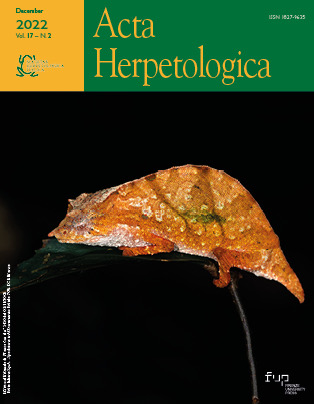Published 2022-08-01
Keywords
- Anurans,
- egg-mass aggregations,
- developmental temperatures
How to Cite
Abstract
The efficacy of most biological processes is temperature dependent and, within physiological limits, on average, warmer is better. This axiom of biology has led to a wide range of adaptations for dealing with temperatures that are outside of an organism’s preferred temperature. Many pond-breeding amphibians lay their eggs during early spring, when water temperatures are near freezing. Communal nest-site selection has been proposed as a mechanism to increase developmental temperatures, and temperatures near the center of egg-mass aggregations are elevated relative to egg-masses on the aggregation’s periphery. It is unclear whether this spatial variation in temperature is due to concentration of metabolic heat, absorption of solar radiation, or both. Here, we explore finer scale spatial variation within egg masses of the wood frog Rana sylvatica, one of the earliest amphibians to breed during the North American spring. We compared peripheral and core temperatures of egg masses that were exposed either to 1) ambient sunlight from above, or 2) sunlight reflected by a mirror from below. We found that differences between core and peripheral temperatures were higher in the control than in the mirror treatment, but core and peripheral temperatures were statistically indistinguishable in both cases. Moreover, the difference in peripheral and internal temperatures increased significantly over the course of development. However, these trends were only significant in ambient sunlight and actually decreased in the mirror group. Our results suggest that the benefits of communal nesting are also experienced by individual egg masses, albeit to a lesser extent. In addition, the lack of effect in shaded egg masses suggests that the thermal advantage is tied to sun exposure and not due to concentration of metabolic heat.
References
Angilletta, M. J., R. B. Huey and M. R. Frazier (2010). Thermodynamic Effects on Organismal Performance: Is Hotter Better? Physiological and Biochemical Zoology 83: 197-206.
Arrighi, J.M., Lencer, E.S., Jukar, A., Park, D., Phillips, P.C., and Kaplan, R.H. (2013) Daily temperature fluctuations unpredictably influence developmental rate and morphology at a critical early larvval stage in a frog. BMC Ecology 13: 18.
Benard, M. F. (2015). Warmer winters reduce frog fecundity and shift breeding phenology, which consequently alters larval development and metamorphic timing. Global Change Biology 21: 1058-1065.
Blanckenhorn, W. U. and D. J. Fairbairn (1995). Life-History Adaptation Along a Latitudinal Cline in the Water Strider Aquarius-Remigis Heteroptera, Gerridae. Journal of Evolutionary Biology 8: 21-41.
Brady, S. P., F. J. Zamora-Camacho, F. A. A. Eriksson, D. Goedert, M. Comas and R. Calsbeek (2019). Fitter frogs from polluted ponds: The complex impacts of human-altered environments. Evolutionary Applications 12: 1360-1370.
Costanzo, J. P. and R. E. Lee (1993). Cryoprotectant Production Capacity of the Freeze-Tolerant Wood Frog, Rana-Sylvatica. Canadian Journal of Zoology-Revue Canadienne De Zoologie 71: 71-75.
Ellner, S. P., N. G. Hairston and D. Babai (1998). Long-term diapause and spreading of risk across the life cycle. Ergebnisse der Limnologie 0: 297-312.
Frazier, M. R., R. B. Huey and D. Berrigan (2006). Hotter is better: Thermodynamics constrains the evolution of insect population growth rates. Integrative and Comparative Biology 46: E45-E45.
Goedert, D. and R. Calsbeek (2019). Experimental Evidence That Metamorphosis Alleviates Genomic Conflict. Am Nat 194: 356-366.
Goldstein, J. A., K. V. Hoff and S. D. Hillyard (2017). The effect of temperature on development and behaviour of relict leopard frog tadpoles. Conservation Physiology 5. e00809
Gosner, K. L. (1960). A simplified table for staging anuran embryos and larvae with notes on identification. Herpetologiea 16: 183-190.
Hassinger, D. (1970). Notes on the thermal properties of frog eggs. Herpetologica 26: 49-51.
Herreid, C. F. and S. Kinney (1967). Temperature and Development of the Wood Frog, Rana Sylvatica, in Alaska. Ecology 48: 579-590.
Huey, R. B. (1991). Physiological Consequences of Habitat Selection. American Naturalist 137: S91-S115.
Knies, J. L., J. G. Kingsolver and C. L. Burch (2009). Hotter Is Better and Broader: Thermal Sensitivity of Fitness in a Population of Bacteriophages. American Naturalist 173: 419-430.
Licht, L. E. (2003). Shedding light on ultraviolet radiation and amphibian embryos. Bioscience 53: 551-561.
Savage, R. (1961). The ecology and life history of the common frog, Rana temporaria temporari. Hafner Publishing Co. United States
Skelly, D. K. (2004). Microgeographic countergradient variation in the wood frog, Rana sylvatica. Evolution 58: 160-165.
Slough, B. G. and R. L. Mennell (2006). Diversity and range of amphibians of the Yukon territory. Canadian Field-Naturalist 120: 87-92.
Storey, K. B. and J. M. Storey (2012). Aestivation: signaling and hypometabolism. Journal of Experimental Biology 215: 1425-1433.
Swierk, L., S. P. Graham and T. Langkilde (2014). The stress of scramble: sex differences in behavior and physiological stress response in a time-constrained mating system. Behavioral Ecology and Sociobiology 68: 1761-1768.
Tryjanowski, P., T. Sparks, M. Rybacki and L. Berger (2006). Is body size of the water frog Rana esculenta complex responding to climate change? Naturwissenschaften 93: 110-113.
Waldman, B. (1982). Adaptive significance of communal oviposition in wood frogs (Rana sylvatica), Behavioral ecology and sociobiology, 10(3), pp. 169–174.






